Getting Physical as We Age
December 07, 2021 Catherine Arnold
Resnick’s research recognizes that older adults in assisted-living settings and nursing homes are particularly at risk for decreased function and physical health, as are older adults with Alzheimer’s.
OUR RESEARCHER: Barbara Resnick, PhD ’96, RN, CRNP, FAAN, FAANP
The Centers for Disease Control and Prevention predicts that by 2050, 40% of all patients treated for nonfatal injuries will be age 65 or older. This has much to do with strength loss, says researcher and clinician Barbara Resnick, PhD ’96, RN, CRNP, FAAN, FAANP, professor, Sonya Ziporkin Gershowitz Chair in Gerontology, and co-director, Biology and Behavior Across the Lifespan Organized Research Center, who has dedicated her career to optimizing function and physical activity among older adults and to facilitating healthy behaviors for this population across care settings.
Resnick’s research recognizes that older adults in assisted-living settings and nursing homes are particularly at risk for decreased function and physical health, as are older adults with Alzheimer’s disease and related dementias who are hospitalized. Maintaining physical activity (e.g., mobility, bathing, dressing) has a positive impact on older adults, including prevention of functional decline, less pain, less delirium, fewer behavioral symptoms, fewer falls, shorter lengths of stay, and reduced unplanned hospital readmissions.
As someone who has contributed significantly to building patients’ resilience through activity and advocating for older patients to help themselves, Resnick says she’d like providers to treat not just the health condition but the lack of motivation for physical activity. To address this, she developed the Function-Focused Care (FFC) approach more than 20 years ago, aimed at overcoming the tendency for caregivers simply to provide care to older adults versus helping them to engage optimally in the activity. This might involve walking to the bathroom versus using a bedpan. In a 2021 study published in the Journal of Aging and Physical Activity, Resnick and colleagues showed that in assisted-living settings, among other known beneficial outcomes, FFC could decrease resident falls, hospitalizations, and transfers to nursing homes. Despite the known benefits of FFC supported by more than 20 studies, physical activity still is not widely encouraged across all care settings among older patients, who spend the majority of their time sedentary.
In a current project, Resnick designed an implementation strategy to optimize function and physical activity and control behavioral symptoms in acute care (AC) settings. This strategy uses the evidence integration triangle (EIT) and a four-step approach in which nurses teach, prompt, help, and motivate older individuals to incorporate physical activity into routine activities and increase the overall time they spend on physical activity. This could include having the individual feed themself rather than being fed by a caregiver. With $2.3 million awarded from the National Institutes of Health in 2020 for use over five years, Resnick will test the effectiveness by comparing hospital units educated in this FFC-AC-EIT strategy versus those exposed to FFC education alone.
“We’ve been able to show we can help maintain function in assisted living and other aging care environments,” says Resnick, who has worked with aging individuals to encourage movement since her teens. As a 16-year-old nursing assistant, she removed physical restraints placed on patients who had wandered or fallen and assisted them in getting up and walking, spurring a decades-long career focused on improving older adults’ motivation to stay mobile.
Resnick formerly served as the president of both the Gerontological Society of America and the American Geriatrics Society and is no stranger to lending her voice as an expert source in the media, having spoken about the importance of exercising after age 40, easing arthritis with movement, and other topics for AARP, HealthDay.com, Healthline.com, Physician’s Weekly, and others. About herself and her research colleagues, she says, “We’ve been thrilled to see nurses and others who provide care to older adults encouraging these individuals to optimize function and increase time spent on physical activity.”
 THIS ARTICLE FIRST APPEARED IN THE FALL 2021 ISSUE OF MAGAZINE.
THIS ARTICLE FIRST APPEARED IN THE FALL 2021 ISSUE OF MAGAZINE.